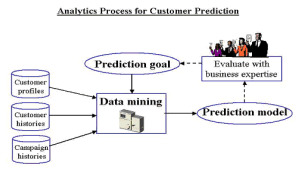|
Analytics + Business Expertise =
Actionable Predictions for Each Customer
by Eric Siegel, Ph. D.
Predictive analytics offers something completely different from standard business reporting and sales forecasting: actionable predictions for each customer. This special form of business modeling foresees each customer purchase, response or cancellation, predicting the individual behavior of each existing or prospective customer under certain conditions. Naturally, per-customer predictions are key to allocating marketing and sales resources. For example, by predicting which product features each customer will respond to, you can target each customer accordingly.
However, per-customer prediction can't work without a healthy injection of your business expertise. To generate customer predictions that will have a business impact, predictive analytics requires a wholly collaborative process driven by business needs and marketing insight. This means you need to meet with your analytics folks a few times a week. This stands in contrast with other data-intensive initiatives, such as deploying a data warehouse or OLAP solution, which, once defined, can be handed off to IT and revisited later to receive the results.
With analytics run as a business activity, you can guide the process towards actionable predictions. For example, your input will help determine precisely which customer actions to predict, and how these predictions will be used. This ensures that the results are actionable within your company's operational framework, and that they have the greatest impact within your company's business model.
There are three steps where business expertise is needed to direct predictive analytics: defining your prediction goal; evaluating the prediction results and redirecting; and deploying your prediction model.

1. Define Your Prediction Goal
Business and analytics experts must collaboratively define the prediction goal. Although there are many aspects of customer behavior that can be predicted with analytics, only a fraction will be business-actionable. It takes an expert in your business to know which predicted behaviors have this business value. Likewise, conceivable prediction goals are limited only by the imagination of your marketing staff, and only a fraction can be achieved with analytics.
Each customer prediction goal must be defined with a great degree of detail, for example:
Response: Which customers will respond to a certain brochure mailing within 13 business days with a purchase value of $125 after shipping?
Repeat customers: Which first-time customers will make five or more additional purchases totaling at least $1,250 within six months?
Cross-sell and upsell: Which customers will purchase product C or D, given a purchase of A or B, within four months, given a mail solicitation?
Attrition: Which customers of more than four months will decrease their monthly usage by 80 percent in the next three months, if no marketing contact is made?
2. Evaluate Prediction Results and Redirect
Your business expertise is needed to choose between certain pragmatic trade-offs in prediction capability. Generally, predictive analytics provides a range of customer segments with varying prediction performance from which you can select. For example, you may need to choose between a group of 100,000 customers with four times greater likelihood of making a purchase than average, versus a group twice as large with only three times the likelihood. These kinds of trade-offs can also be examined in terms of profit, market penetration, or a measure of loyalty like one-year customer value.
In some cases prediction results are not strong enough, requiring that the defined prediction goal be altered, under business supervision. For example, it may be discovered that the targeted customer behavior has not occurred frequently enough historically to train the prediction model (e.g., customers very rarely up-sell from product A to product B).
In other cases prediction results reveal errors or misguided business assumptions. For example, even when attrition prediction is successful, it may then become clear from the business side that predictions must be made two months earlier to be actionable. Certain data problems are discovered only after initial prediction models are generated. These include misunderstood variable meanings, heavy reliance on expensive data sources, accidental biases in data sampling, or mundane data errors that require a data cleansing process.
In the best cases unexpected results inspire the collaborative definition of new prediction goals. Sometimes, variables that prove important for prediction come as a surprise, inspiring the addition of related data sources.
3. Deploy Your Prediction Model
How customer predictions are used as part of business operations is up to your marketing creativity and business philosophy. For example, if repeat customers are predicted, marketing resources could be directed toward non-repeaters to improve their value, or toward repeaters to leverage their existing value. Predictions can trigger targeted market campaigns or guide sales activities, such as personalized up-sales efforts at unsolicited touch points.
With business expertise directing each step, your analytics process will produce actionable predictions for each customer with a business impact.
To learn what a predictive model looks like and how it is created, see the article, "Predictive Analytics with Data Mining: How It Works."
About the Author
Eric Siegel, Ph.D., is President of San Francisco-based Prediction Impact, providing analytics training and services to medium through Fortune 100 companies. He is an expert in data mining and predictive analytics and an award-winning teacher of graduate-level courses in those areas. Siegel served as a computer science professor at Columbia University, where he forwarded data mining technology in the realms of machine learning performance optimization, text mining and data visualization. He cofounded two New York City-based software companies for customer/user profiling and data mining. With data mining, Eric has also solved problems in computer security, fraud detection, computational linguistics and information retrieval. You can reach him at eric@predictionimpact.com or (415) 683-1146.
|

